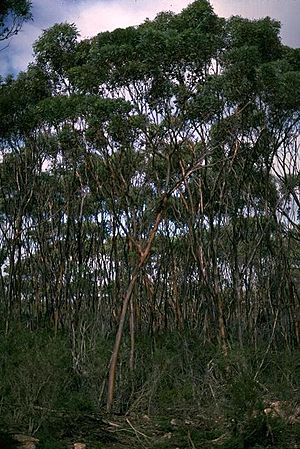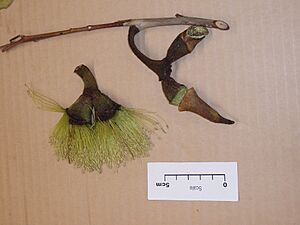Beaufort Inlet mallee facts for kids
Quick facts for kids Beaufort Inlet mallee |
|
|---|---|
 |
|
| Conservation status | |
| Scientific classification | |
| Genus: |
Eucalyptus
|
| Species: |
newbeyi
|
The Beaufort Inlet mallee (scientific name: Eucalyptus newbeyi) is a special type of mallee tree. It only grows in a small area on the southern coast of Western Australia. This unique tree has smooth, patchy bark and narrow leaves. Its flowers are usually yellowish-green and grow in groups of seven. After flowering, it produces bell-shaped or cone-shaped fruits.
Contents
What Does the Beaufort Inlet Mallee Look Like?
The Beaufort Inlet mallee is a type of mallee tree. This means it has many stems growing from the ground, like a bush. It usually grows to be about 5 to 8 meters (16 to 26 feet) tall. This mallee does not have a special woody swelling at its base called a lignotuber.
Its bark is smooth and has a mottled (patchy) look. It's yellowish-brown and peels off in flakes. The adult leaves are narrow, shaped like a spear or a thin oval. They are about 40 to 80 millimeters (1.6 to 3.1 inches) long and 5 to 15 millimeters (0.2 to 0.6 inches) wide. Each leaf tapers down to a small stalk called a petiole, which is about 5 to 10 millimeters (0.2 to 0.4 inches) long.
Flowers and Fruit
The flower buds grow in groups of seven, though sometimes there are three or nine. They are found where the leaf meets the stem, which is called the leaf axil. These buds hang down on a flat, strap-like stalk called a peduncle, which is 30 to 55 millimeters (1.2 to 2.2 inches) long. The individual buds do not have their own stalks; they are sessile.
When the buds are ready to open, they are about 52 to 60 millimeters (2.0 to 2.4 inches) long and 11 to 16 millimeters (0.4 to 0.6 inches) wide. They have a horn-shaped cap, called an operculum, which is much longer than the cup-shaped base of the flower. This mallee blooms between September and February. Its flowers are a yellowish-green color.
After the flowers, the tree produces woody fruits. These fruits are shaped like a bell or a cone. They are about 10 to 27 millimeters (0.4 to 1.1 inches) long and 18 to 28 millimeters (0.7 to 1.1 inches) wide. These fruits are actually capsules that hold the seeds.
How to Tell it Apart from Similar Trees
The Beaufort Inlet mallee looks a bit like two other eucalypt trees.
- It is different from the Burdett gum (Eucalyptus burdettiana) because its horn-shaped cap (operculum) is smooth, not warty.
- It is also different from the warted yate (Eucalyptus megacornuta). The warted yate has very warty bud caps and bell-shaped fruits.
Who Discovered and Named This Tree?
The Eucalyptus newbeyi was first officially described in 1980. This means it was formally named and written about for the first time. The scientists who did this were Denis Carr and Stella Carr. They wrote about it in a science journal called the Australian Journal of Botany.
They studied samples of the tree that were collected in 1970. These samples were found near the Fitzgerald River by a plant collector named Alex George. The special part of its name, newbeyi, honors Ken Newbeyi (1936-1988). He was a botanist and ecologist from Ongerup who collected many plants.
Where Does the Beaufort Inlet Mallee Grow?
The Beaufort Inlet mallee is found in a specific part of Western Australia. It grows on steep slopes and cliffs along riverbanks. You can find it in shrubland areas near Beaufort Inlet. It also grows inside the Fitzgerald River National Park. This tree prefers to grow in sandy-clay-loam soils.
Is This Tree Protected?
Yes, the Beaufort Inlet mallee is considered a special plant. The Western Australian Government's Department of Parks and Wildlife has classified it as "Priority Three".
This means that:
- We don't know a lot about how many of these trees exist.
- They are only found in a few specific places.
- However, they are not currently in immediate danger of disappearing.
It's important to keep an eye on these trees to make sure they stay safe and healthy in the future.



